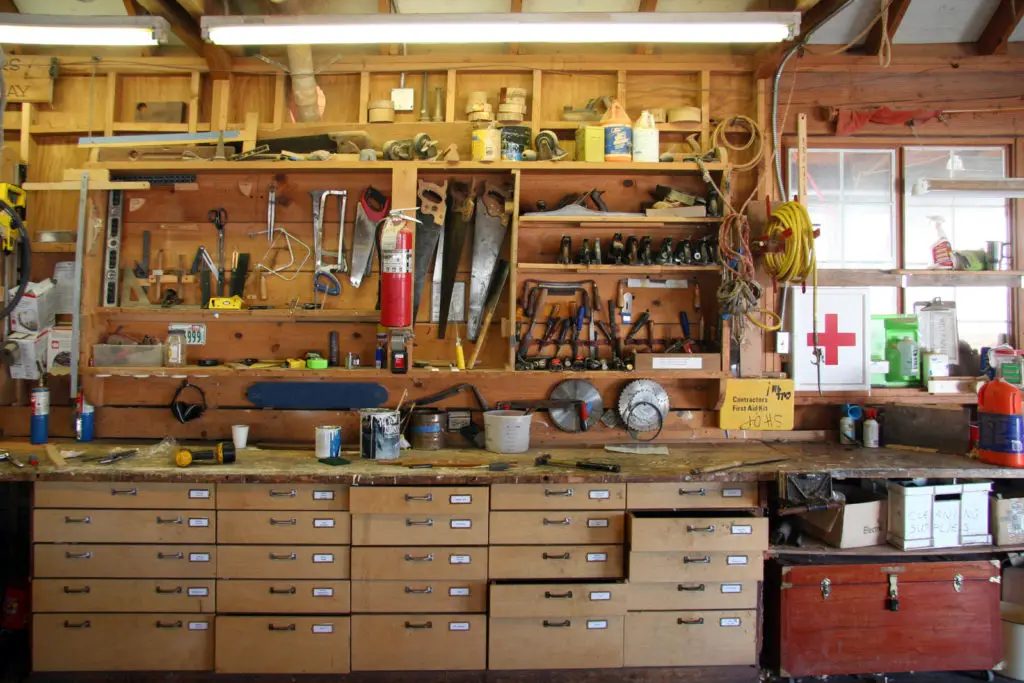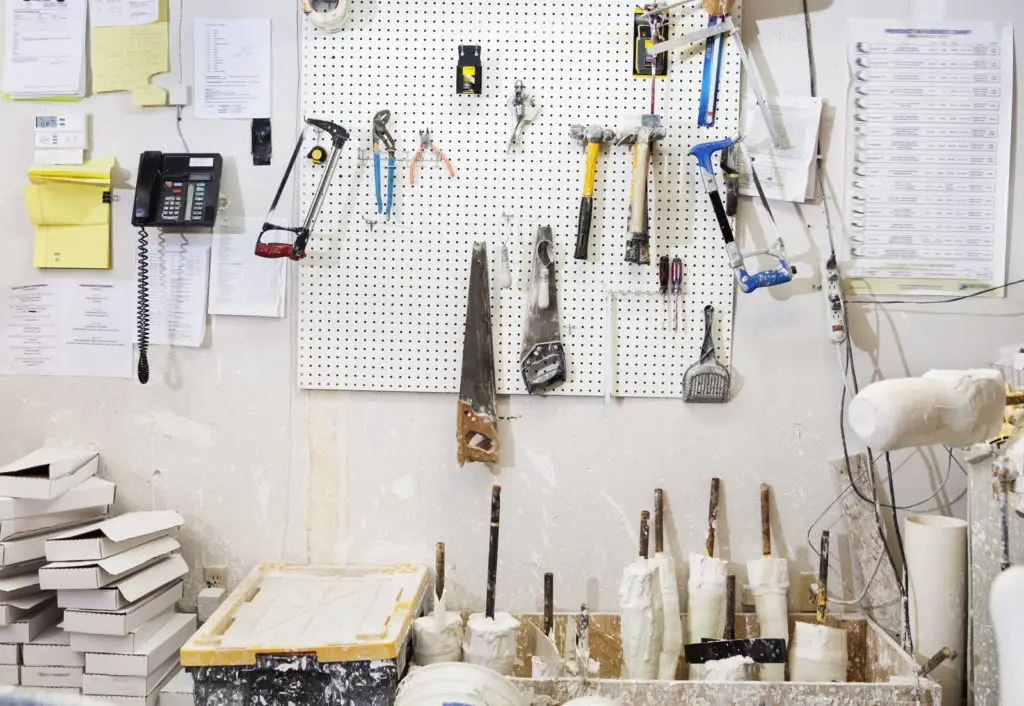A carpenter workshop is a place where people learn about woodworking.
Carpenter workshops are available to the general public but do not offer any certification or degree. Carpenter workshops are typically held for a short time in order to teach carpentry skills and techniques.
Carpenters who attend these classes will go back home and create their own items with their newly learned knowledge. Carpenters can also use this knowledge at work by using what they have learned on the job site and during off-hours with projects around the house or personal hobby ventures.
The following guide will help you do just that without getting too overwhelmed or running into any snags along the way!
What Is a Carpentry Workshop?
All of the professional tools necessary to meet any construction need are available at your local carpentry workshop. This includes saws such as panel, bandsaw, and jigsaw blades, shaping devices like planers for wood removal or joining pieces together with clamps in between them (like this one!), striking instruments including drills & drivers that can drive screws into hardwood all day long!
Power tool functions include sanding curves along their surface, so they look beautiful again after years spent outdoors without protection against weather elements).
How to Plan Your Carpentry Workshop
Planning a carpentry workshop is a lot like planning any other professional setting where people will be learning.
In order to have a good grasp of how to plan, here are the necessary considerations you will want to think about when creating your carpentry workshop:
1. Select Your Carpentry shop Objectives
Carpentry business objectives are the goals that you want to achieve. These could be anything from “build furniture for my customers” or “teach the basics of woodworking to individuals who are interested in learning more” or “sell finished projects made by me to everyone.”
Creating a good carpentry business objective will help you become more focused on what type of business you want to build.
2. Pay Attention to Storage and Organization
Tools can be left all over the place, typically with no rhyme or reason. When planning your workshop, always keep in mind where tools will be stored and how easy it will be for people to find them.
If a tool is not packed away properly, this can lead to accidents because people are unaware of their surroundings, which could be potentially dangerous for every woodworker working there.
Anytime you need to store your tools, take the time to measure the area where you would like them stored. You can then either purchase a tool chest or make your own to fit neatly into the area you’ve picked.
Remember that you will need to make sure your storage units are deep enough to fit all of your tools. If they are not, you may have to stack wood onto the unit to make it possible for your tools to fit in their respective slots.
3. Identify Your Carpentry Workshop Location
Finding your carpentry workshop location is as simple as looking around outside. But you should also think about where you would like to go if the weather is not great.
A carpentry workshop can easily be held inside a garage, barn, or even the basement of a house if you have one. Major appliances are typically not found in these places, but an electrician can easily hook up a power source to the building if necessary.
If you are going to be working outside, then there is no need for electricity. Providing shade from the sun would be a nice addition to any outdoor carpentry workshop, as well as wind protection from those crazy spring days.
You will also want an area where you can place your tools along with a sturdy workbench for people who prefer using hand tools. You will also need a flat surface where you can place your completed projects before they head home with their owners.
4. Layout Your Carpentry Workshop

Now that you know what type of carpentry workshop you want to build, the next step is to figure out how big it should be and look overall. It’s very common for carpentry workshops to have a designated space for each of the following:
- A workbench that is as long as possible. People who build things with their hands will appreciate this feature because it allows them to leave the project they are working on where they left it without having to worry about forgetting details or losing parts.
- An area where each person can place their finished projects. With a long workbench, you will also want somewhere for other woodworkers to put their completed woodworking projects instead of leaving them on the floor.
- A designated storage area for all the necessary tools. If you plan to purchase a complete set of carpentry tools, this may not be needed in your carpentry workshop.
- But if you choose to put together a collection of tools on your own, it would be helpful to have an area where you can place them after
Now it’s time to finalize your plans by double-checking that everything is correct and finding outside sources to back up what you’ve just created on paper.
5. Plan For Ample Light and Electrical Power
Unsurprisingly, people do not enjoy working in an environment where it is hard to see the projects they are working on, so it’s a good idea to have ample lighting that can be switched off and on easily.
You should also plan for a power source because you may need to use some of your tools while you’re away from the carpentry workshop.
6. Workbench Cabinet
Cabinets are a great place to store all of your tools and other carpentry supplies. You can make them extra tall by adding a cabinet beneath the top surface where you can store your taller items such as gloves, goggles, and ear protection.
These cabinets should always be locked so that people have to ask for help in order to get their hands on the tools they need. This will also help prevent accidents of young children who might not understand the dangers of playing around with sharp objects and power tools.
7. Reducing Noise While Working
Ear protection is another essential addition to your carpentry workshop. It will help prevent hearing loss if you are regularly exposed to loud noises because it muffles the sound around you instead of eliminating it.
People who regularly use power tools in their carpentry workshops will also want to wear goggles because these items can kick up dust that might accidentally get into the eyes of the person using them.
8. Purchase the Supplies You Need
Now comes the time where you can actually go shopping for all of the items you need to create your carpentry workshop. If you choose a pre-set package, this will be very easy because you’ll have everything in one place, and it won’t require any extra tools that aren’t already included with the set.

If you don’t choose a pre-set package and instead choose to put together your own toolset, you’ll need all of the basic tools listed above and any other items you think you will use frequently.
Once the carpentry workshop is built and exactly how you want it, it’s time to begin using those tools and building something.
9. Ventilation and Dust
Ventilation and dust are two additional aspects that should be considered when you’re building a carpentry workshop. Without proper ventilation, the area can quickly become dusty and unpleasant to work in for both you and other people who may be around while you work.
You will also want to make sure you have proper dust collection in the carpentry workshop, including a shop vacuum for smaller tasks which will save time and money compared to purchasing multiple tools for different tasks.
10. Level the Floor
Now that you’ve finished building the carpentry workshop, it’s time to take care of smaller details like making sure the floor is level so your tools won’t slide when they’re in use.
This can be done by adding feet underneath tables and cabinets or using spacers underneath them on the carpet.
Following are tips on how you can level up your floor for smooth and productive carpentry work:
- Use wood shims to level up cabinets or tables that are on the carpet. You can also purchase metallic adjustable feet for this purpose, but they will cost more than the average person is willing to pay, so it’s often better to use this method if you do not want to invest more money into your carpentry workshop.
- If you have hardwood or tiled floors, the best solution is to place your carpentry workshop on an elevated platform simply. This can be made using plywood which you can purchase at your local hardware store.
11. Have Proper Safety Gears & Equipment
Carpentry is always a dangerous job, and you have to be very careful about possible accidents. You should have all the necessary things with you for your protection.
You need to have the following safety gears & equipment:
- Gloves – Gloves are used to protect hands from sharp objects or scratches. Gloves are available in different materials like leather, latex, rubber, etc.
- Earplugs – To protect your ears from the noise of heavy machines, you should always have earplugs with you. Several other things are very important to be kept with you for safety purposes.
- A First Aid Box – Whenever you’re working on it, there might be some accident that causes injury. So, for this very purpose, you should keep a first aid box with yourself. You can find it easily in the medical stores or any local pharmacy shop. It includes basic things like cotton swabs, bandages, etc., to help you in an emergency condition.
- A Tool Belt – A tool belt is used to avoid losing or misplacing tools while working on carpentry. It also keeps all your needed tools within reach, and you can use them more easily and quickly.
- Eye Protection – Eye protection is mandatory while working in a carpentry workshop. You have to use safety glasses with side shields or a full face shield to protect your eyes from accidents.
12. Add Pegboard for Storage
You can use pegboard to store your tools. It’s easy to install, durable, and very useful for any carpentry workshop.

|
Useful Tips
|
|---|
Following these steps will make it easier for you to build your carpentry workshop and get all the equipment needed in one go.
13. Cover the Walls With Wood Paneling
Adding wood paneling to the walls of your carpentry workshop will look good and increase the value of your carpentry workshop.
It’s wise that you don’t put up lots of shelves and cabinets as they make a room look smaller and disorganized.
Don’t try to fill every available space on the wall; keep some of them empty to make your carpentry workshop look spacious.
You can use cabinets and shelves at the place which is more frequently used. For example, you might need a larger shelf on the opposite wall near one of the power plugs for all your heavy machine tools.
14. Schedule Regular Maintenance
You should always try to keep your carpentry workshop clean and organized as you need to find any tool from the mess in a very short span of time. Doing this also adds extra value to your carpentry workshop as a well-maintained carpentry workshop looks good, presentable, and it’s easy to operate too.
Your carpentry workshop should be well lit. So, you shouldn’t place all the lights in just one place.
You need to place them in such a way that they give an even light all around your carpentry workshop.
15. Spread the Word About Your Workshop
It’s a great idea to let your friends, relatives, and acquaintances know about your carpentry workshop. They will ask for some tools or furniture pieces that you can repair or make on demand.
This will save you the trouble of going out and looking for new customers and help you earn some extra cash during your free time.
If you are new to carpentry, you should start your career by repairing things around the house.
Then with experience, you can progress towards making furniture pieces and selling them.
Once you learn everything about woodworking, it becomes easy to make something really beautiful that will fetch a good price.
16. Make Your Messy Drawer Adjustable
Although they are not easy to clean, messy drawers might be the only way you can make everything fit inside your carpentry workshop. But if possible, it is a good idea to have at least one drawer that will be adjustable so you will still have access to all of your tools.
17. Using Drawer Dividers Can Help You Stay Organized
Consider using drawer dividers instead of simply stuffing your tools into a drawer and letting them bounce around every time you open them. This way, you can separate your tools according to their size and the types of projects they are most useful for.
Tools Needed for Your First Carpentry Workshop
- Marking Gauge: Essential for marking and measuring accurately.
- Clamps: You will need at least three clamps for your carpentry workshop.
- Combination Square: It is used for marking square lines and checking the accuracy of right angles.
- Carpenter’s Chisel: It has a tapered cutting edge, ideal for smoothing or shaping edges.
- Carpenter’s Mallet: You will need a strong and large mallet, as it is used for striking chisels and cutters.
- Sliding Bevel: It is an important carpenter tool used for transferring angles when cutting.
- Coping Saw: A coping saw is used to cut intricate curves and joints. You can start with a hand-coping saw.
- Wood Planer: It is needed to flatten and smoothen rough surfaces of wood.
- Electric Drill: You will need an electric drill to drive screws and drill holes into wood.
- Hammer: You will need a hammer for all your nail-related works.
- Smoothing Plane: It is a carpenter tool used to flatten and smooth surfaces.
- Hand Saw: You will need many hand saws, including tenon saws and carcass saws.
- Mallet: It is used to hit chisels, cutters, and other small carpenter tools.
- Sharpening Stones: You will need flat and round sharpening stones.
- Circular Saw: This is a portable saw used to cut dimensional lumber.
- Router: A router is useful for making grooves into the wood.
- Chisel Set: A complete set of chisels will make life easier for you.
- Random Orbital Sander: It is used for removing rough surfaces and smoothening wood.
These tools and materials are enough to give you a start in your carpentry workshop. Once you acquire experience in them, you can move on to more advanced projects that will teach you how to use more tools in your everyday carpentry work.
Tips for Getting the Most Out of Your Carpentry Workshop From Experienced Woodworkers
One of the main secrets for getting more comfortable working in a carpentry workshop is to organize your tools and materials as much as possible.
Then it is a good idea to keep your workspace clean and tidy as it will make it easier for you to find the tools you need.
Once you have mastered using your tools, it will be a lot easier for you to execute larger projects.
In order to achieve that level of comfort, you will have to put some effort into practicing the techniques of using the tools.
The most important thing is not to be discouraged if you don’t get it right the first time.
The Benefits of Having an Organized Carpentry Workshops
Teaching the Importance of Safety and Organization
Carpentry workshops need to be organized so that they can create an efficient and safe learning environment for students. The importance of safety while working with machinery cannot be understated. With the proper organization, students can learn how to use tools safely while also avoiding injury or mishap.
Improving Carpentry Skills and Knowledge
With a more organized carpentry workshop, students will learn how to use the tools and understand their uses effectively. They can explore the different kinds of tools without accidents since they can keep them in the right place.
Keeping Children and Adults Interested and Active in Their Work
Whether they are children or adults, people need to have their own space. By efficiently organizing a carpentry workshop, students will enjoy their workspaces and practice working independently.
In Summary
Now that you’ve learned how to plan out your carpenter workshop and use the space efficiently, you can begin to finish your carpentry workshop. You will need some tools and material as well as knowledge of certain basic carpentry skills. It will take a lot of time and effort, but it’s worthwhile in the end when you see your finished carpenter workshop. Now that you’ve planned out your project, you can move on to the next step: building your workshop.

